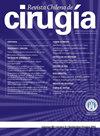Sutura laparoscópica frente a sutura por laparotomía en úlceras gastroduodenales perforadas
Q4 Medicine
引用次数: 0
Abstract
Introduction: Gastroduodenal perforation continues to be a relatively frequent surgical emergency, despite advances in the medical treatment of ulcer disease. Its laparoscopic approach has been increasing in the last years, although it has not been generalized. Objective: Was to analyze the postoperative results in patients with perforated ulcer treated with laparoscopic suture, and to compare them with a similar group with laparotomy suture. Our hypothesis was that laparoscopic suture is a safe option and with less morbidity than the laparotomy approach. Material and Methods: Comparative retrospective analysis of two patient cohorts: one treated with laparoscopic suture during 2014 and 2015, a period in which this approach was fully implanted in the emergency room in our hospital, and another comparable group treated by suture for open surgery during the period 2001-2003. Complications were analyzed according to Clavien-Dindo classification, conversion rate, mean stay and mortality. Results: The groups were comparable in age, sex, comorbidities and anesthetic risk. There was a trend towards superiority in favor of the laparoscopic approach in certain variables analyzed, with a conversion rate of 3%. The presence of early postoperative complications was greater in the laparotomy suture group: post-surgical septic shock (15.2% vs 6%) and wound infection (15.2% vs 3%), as well as medical complications, although not significantly. The group with laparoscopic suture had a longer surgical time, lower mean stay and lower mortality. Conclusion: The laparoscopic suture of the gastroduodenal ulcer in our center has had a very low conversion rate and a somewhat lower morbidity to the laparotomy suture, with a lower rate of reinterventions and a mean stay, despite a longer surgical time.胃十二指肠穿孔溃疡的腹腔镜缝合与腹腔镜缝合
导读:胃十二指肠穿孔仍然是一个相对频繁的外科急诊,尽管在溃疡疾病的医学治疗进展。它的腹腔镜方法在过去几年一直在增加,尽管它还没有推广。目的:分析腹腔镜缝合治疗溃疡穿孔患者的术后效果,并与剖腹缝合组进行比较。我们的假设是腹腔镜缝合是一种安全的选择,比剖腹手术的发病率更低。材料与方法:比较回顾性分析两组患者:一组患者于2014年至2015年在我院急诊室完全植入腹腔镜缝合,另一组患者于2001年至2003年在开放手术中缝合。根据Clavien-Dindo分类、转换率、平均住院时间和死亡率对并发症进行分析。结果:两组在年龄、性别、合并症和麻醉风险方面具有可比性。在分析的某些变量中,有倾向于腹腔镜入路的优势,转换率为3%。剖腹缝合组的早期术后并发症发生率更高:术后感染性休克(15.2%比6%)和伤口感染(15.2%比3%),以及医学并发症,尽管不明显。腹腔镜缝合组手术时间长,平均住院时间短,死亡率低。结论:我中心腹腔镜胃十二指肠溃疡缝合术的转换率很低,与开腹缝合相比发病率较低,手术时间较长,但再干预率较低,平均住院时间较短。
本文章由计算机程序翻译,如有差异,请以英文原文为准。
求助全文
约1分钟内获得全文
求助全文
来源期刊

Revista Chilena De Cirugia
Medicine-Surgery
CiteScore
0.20
自引率
0.00%
发文量
0
审稿时长
6-12 weeks
期刊介绍:
La Revista Chilena de Cirugía es un órgano de difusión del conocimiento y actividad quirúrgica. Su población objetivo son cirujanos, especialistas de otras áreas médicas, médicos generales y alumnos del área de la salud.
Sirve a cirujanos y otros especialistas, para publicar artículos originales e inéditos sobre temas médicos, en particular artículos de investigación básica y clínica, artículos de revisión, entre otros.
Buscan difundir y actualizar el conocimiento médico general y quirúrgico en particular. Se publica en forma bimestral.
La Revista Chilena de Cirugía está afiliada y patrocinada por la Sociedad de Cirujanos de Chilese desde el año 1952.
 求助内容:
求助内容: 应助结果提醒方式:
应助结果提醒方式:


